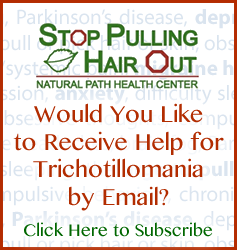 Amino acid therapy can be very effective at restoring proper neurotransmitter function and alleviating the insatiable urge to pull that some many people with trichotillomania experience. There are really two ways in which amino acids are used for people with trichotillomania. The first is to use n-acetyl cysteine, or NAC, which has been shown in clinical trials to reduce the urge to pull in about 56% of people that use NAC (see our post entitled N-acetylcysteine and Treatment of Trichotillomania for more information). NAC is thought to work by increasing the concentration of glutamate (an excitatory neurotransmitter) in a part of the brain that reduces compulsive behavior and hair pulling. Glutamate works in conjunction with GABA (an inhibitory neurotransmitter) to control many functions in the body. Thus, NAC provides a safe and moderately effective strategy to use amino acid therapy to decrease the urge to pull associated with trichotillomania.
Amino acid therapy can be very effective at restoring proper neurotransmitter function and alleviating the insatiable urge to pull that some many people with trichotillomania experience. There are really two ways in which amino acids are used for people with trichotillomania. The first is to use n-acetyl cysteine, or NAC, which has been shown in clinical trials to reduce the urge to pull in about 56% of people that use NAC (see our post entitled N-acetylcysteine and Treatment of Trichotillomania for more information). NAC is thought to work by increasing the concentration of glutamate (an excitatory neurotransmitter) in a part of the brain that reduces compulsive behavior and hair pulling. Glutamate works in conjunction with GABA (an inhibitory neurotransmitter) to control many functions in the body. Thus, NAC provides a safe and moderately effective strategy to use amino acid therapy to decrease the urge to pull associated with trichotillomania.
However, we have found that a more effective way to implement amino acid therapy in regards to trichotillomania is to address the serotonin/dopamine system. By providing the brain the proper proportion of the necessary amino acid precursors and cofactors necessary to achieve optimal serotonin and dopamine function we have had an 86% success rate with eliminating the urge to pull, as opposed to just reducing the urge to pull.
This increased success rate is attributed to the fact that dopamine exhibits control over the release of glutamate and GABA in certain parts of the brain. Therefore, the imbalance between glutamate and GABA that leads to trichotillomania in most people is likely to be caused by an imbalance with dopamine and serotonin (as they are farther upstream). By optimizing serotonin and dopamine function, all the systems downstream, including glutamate and GABA normalize as well. When this happens, the urge to pull disappears.
Another key distinction between using NAC or this balanced amino acid approach is the ability to remain symptom free once the amino acid(s) have been discontinued. With NAC, the urge to pull often returns once the supplement is discontinued (this provides further evidence that NAC may not be addressing the root cause of the imbalance). However, with balanced amino acid therapy we have found that once optimized neurotransmitter function is established and maintained for a period of time, most people can reduce or eliminate the amino acids and remain symptom free utilizing dietary and lifestyle factors to maintain optimal neurotransmitter status. This means that it is very likely you won’t have to take these supplements forever and you can remain trichotillomania-free. This occurs because we are addressing the underlying root imbalance that seems to lead to the urge to pull for most people with trichotillomania. By correctly the underlying neurotransmitter imbalance with balanced amino acid therapy you effectively eliminate the problem, which allows you to stop pulling your hair out.


This article is incorrect. NAC does not increase glutamate levels. It has effects on the cystine-glutamate antiporter by providing more cystine to be taken up into the neurons, thereby releasing more glutamate into the extra cellular space. However, these increased levels act upon receptors as negative feedback, resulting in an overall DECREASE in glutamate levels.
Hi Sam –
Thanks for your comment; you are correct. For the sake of simplicity, I eluded to only half of the action of NAC on glutamate levels.
The more complete version goes like this: N-acetyl cysteine increases the uptake of cystine.
Uptake of cystine activates a reverse transport of glutamate into the extracellular space, thereby increasing glutamate in the extracellular space.
Restoring glutamate to the extracellular space inhibits further release of glutamate which can improve compulsive behaviors and reduce the urge to pull.
Thanks for your comment and keen-eye –
Sincerely,
Dr. Chad